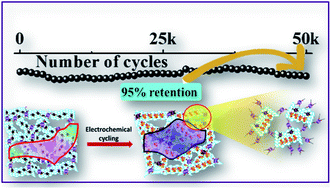当前位置:
X-MOL 学术
›
J. Mater. Chem. A
›
论文详情
Our official English website, www.x-mol.net, welcomes your
feedback! (Note: you will need to create a separate account there.)
Electrochemically customized assembly of a hybrid xerogel material via combined covalent and non-covalent conjugation chemistry: an approach for boosting the cycling performance of pseudocapacitors
Journal of Materials Chemistry A ( IF 10.7 ) Pub Date : 2020/03/17 , DOI: 10.1039/d0ta02477e Taniya Purkait 1, 2, 3 , Dimple 1, 2, 3 , Navpreet Kamboj 1, 2, 3 , Manisha Das 1, 2, 3 , Subhajit Sarkar 1, 2, 3 , Abir De Sarkar 1, 2, 3 , Ramendra Sundar Dey 1, 2, 3
Journal of Materials Chemistry A ( IF 10.7 ) Pub Date : 2020/03/17 , DOI: 10.1039/d0ta02477e Taniya Purkait 1, 2, 3 , Dimple 1, 2, 3 , Navpreet Kamboj 1, 2, 3 , Manisha Das 1, 2, 3 , Subhajit Sarkar 1, 2, 3 , Abir De Sarkar 1, 2, 3 , Ramendra Sundar Dey 1, 2, 3
Affiliation

|
Organic quinones conjugated with a conductive support like graphene via a covalent and/or non-covalent approach are emerging as low-cost and sustainable alternatives to conventional pseudocapacitive materials because of their fast and reversible redox kinetics. Herein, for the first time, reduced graphene oxide (rGO) networks functionalized with the eco-friendly dopamine (DA) moiety in a combined covalent and non-covalent manner have been explored by a facile hydrothermal synthesis method as high-performance pseudocapacitive materials. Further, a unique in situ electrochemical polymerization approach has been undertaken in an attempt to boost the overall storage capacity as well as cycling stability. Electrochemical tuning of the active material can result in an enhancement in the specific capacitance via dual improvement in faradaic and capacitive current as compared to the initial xerogel material, highlighting the significance of the in situ process. The electrode material shows a highest specific capacitance (CSP) of 348 F g−1 at a current density of 0.5 A g−1 in 1 M H2SO4 while retaining 60% of its initial capacitance even at a very high current density of 200 A g−1. A metal-free all-solid-state symmetric supercapacitor was developed with the in situ electropolymerized active material and the as-fabricated device exhibits an excellent CSP of 218 F g−1 at 0.325 A g−1 in 1 M PVA/H2SO4 gel electrolyte with a maximum energy density of 30.3 W h kg−1 and power density up to 13 kW kg−1. Most importantly, the material exhibited an extraordinary stability of 53 000 charge–discharge cycles while retaining 94% of its initial capacitance, while the device also shows an excellent capacitance retention of 92% even after 10 000 continuous cycles. Simultaneously, the DFT study was amended to understand the covalent and non-covalent interaction of the redox species, its charge storage mechanism and charge density distribution as well as to calculate the density of states.
中文翻译:

通过共价和非共价共轭共轭化学方法对混合干凝胶材料进行电化学定制组装:提高伪电容器循环性能的方法
通过共价和/或非共价方法与诸如石墨烯之类的导电载体共轭的有机醌,由于其快速和可逆的氧化还原动力学特性,已成为传统伪电容材料的低成本且可持续的替代品。在本文中,首次通过简便的水热合成方法探索了以生态友好的多巴胺(DA)部分以共价和非共价组合方式进行功能化的还原氧化石墨烯(rGO)网络,作为高性能的假电容材料。此外,独特的原位为了提高总存储容量以及循环稳定性,已经进行了电化学聚合方法。与初始干凝胶材料相比,活性材料的电化学调谐可通过法拉第电流和电容电流的双重改善来提高比电容。这突出了原位工艺的重要性。电极材料在1 MH 2 SO 4中的电流密度为0.5 A g -1时,显示出348 F g -1的最高比电容(C SP),即使在非常高的电流密度下也保持其初始电容的60%。 200 A g -1。利用原位电聚合活性材料开发了无金属全固态对称超级电容器,制成的器件在1 M PVA / H 2中的0.325 A g -1下表现出218 F g -1的出色C SP SO 4凝胶电解质,最大能量密度为30.3 W h kg -1,功率密度最高为13 kW kg -1。最重要的是,该材料在保持其初始电容的94%的同时具有5.3万次充放电循环的非凡稳定性,而该器件甚至在经过一万次连续循环后仍具有92%的出色电容保持率。同时,对DFT研究进行了修改,以了解氧化还原物质的共价和非共价相互作用,其电荷存储机制和电荷密度分布以及计算态密度。
更新日期:2020-04-08
中文翻译:

通过共价和非共价共轭共轭化学方法对混合干凝胶材料进行电化学定制组装:提高伪电容器循环性能的方法
通过共价和/或非共价方法与诸如石墨烯之类的导电载体共轭的有机醌,由于其快速和可逆的氧化还原动力学特性,已成为传统伪电容材料的低成本且可持续的替代品。在本文中,首次通过简便的水热合成方法探索了以生态友好的多巴胺(DA)部分以共价和非共价组合方式进行功能化的还原氧化石墨烯(rGO)网络,作为高性能的假电容材料。此外,独特的原位为了提高总存储容量以及循环稳定性,已经进行了电化学聚合方法。与初始干凝胶材料相比,活性材料的电化学调谐可通过法拉第电流和电容电流的双重改善来提高比电容。这突出了原位工艺的重要性。电极材料在1 MH 2 SO 4中的电流密度为0.5 A g -1时,显示出348 F g -1的最高比电容(C SP),即使在非常高的电流密度下也保持其初始电容的60%。 200 A g -1。利用原位电聚合活性材料开发了无金属全固态对称超级电容器,制成的器件在1 M PVA / H 2中的0.325 A g -1下表现出218 F g -1的出色C SP SO 4凝胶电解质,最大能量密度为30.3 W h kg -1,功率密度最高为13 kW kg -1。最重要的是,该材料在保持其初始电容的94%的同时具有5.3万次充放电循环的非凡稳定性,而该器件甚至在经过一万次连续循环后仍具有92%的出色电容保持率。同时,对DFT研究进行了修改,以了解氧化还原物质的共价和非共价相互作用,其电荷存储机制和电荷密度分布以及计算态密度。










































 京公网安备 11010802027423号
京公网安备 11010802027423号